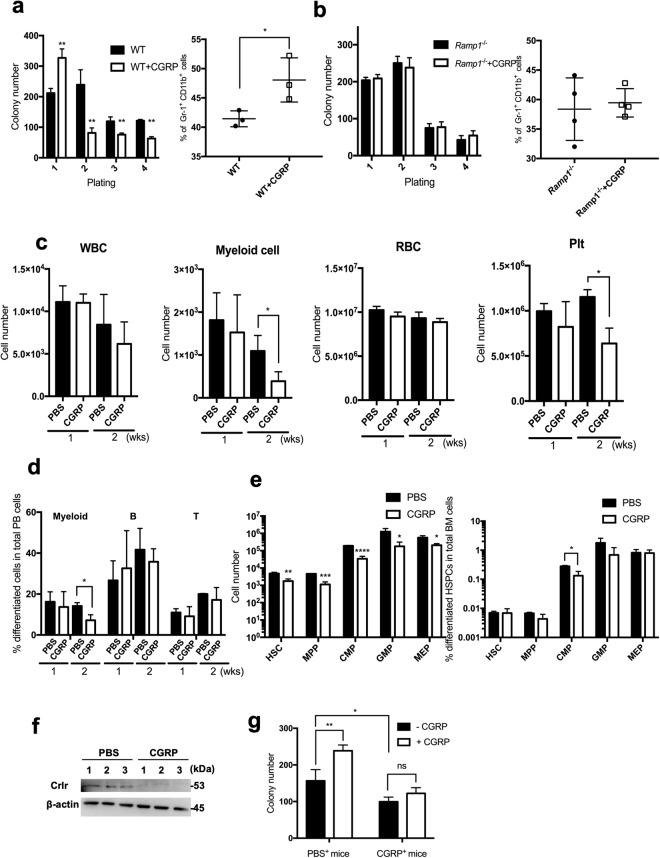Figure 4.
Long-term CGRP treatment affects hematopoiesis. (a) The colony-forming abilities of BMMNCs (left) and the percentage of Gr-1+CD11b+ cells in BMMNCs (right) from WT mice were determined by serial plating in methylcellulose culture with or without CGRP (100 nM). Data are shown as means ± SD of three mice. *p < 0.05, **p < 0.01 compared with WT mice (Student’s t test). (b) The colony-forming abilities of BMMNCs (left) and the percentage of Gr-1+CD11b+ cells in BMMNCs (right) from Ramp1−/− mice were determined by serial plating in methylcellulose culture with or without CGRP (100 nM). Data are shown as means ± SD of three mice. (c) The WBC, myeloid cells, RBC, and Plt counts in the PB of WT mice treated with CGRP or PBS for one and two weeks were determined. Data are shown as means ± SD of three mice. *p < 0.05 compared with PBS-treated mice (Student’s t test). (d) The percentages of differentiated white blood cells populations (myeloid cells, B cells, and T cells) in PB cells from WT mice treated with CGRP or PBS for two weeks were determined. Data are shown as means ± SD of three mice. *p < 0.05 compared with PBS-treated mice (Student’s t test). (e) The cell numbers (left) and percentages (right) of hematopoietic progenitor subpopulations (HSC, MPP, CMP, GMP, and MEP) in BMMNCs of WT mice treated with CGRP or PBS for two weeks were determined. Data are shown as means ± SD of three mice. *p < 0.05, **p < 0.01, ***p < 0.001, ****p < 0.0001 compared with PBS-treated mice (Student’s t test). (f) Expression levels of Crlr in BMMNCs of WT mice treated with CGRP or PBS for two weeks was determined by immunoblot analysis. BMMNCs from three mice for each group were analyzed. The full-length gels/blots are presented in Supplemental Fig. S4. (g) The colony forming abilities of BMMNCs of PBS-treated (PBS+) or CGRP- treated (CGRP+) mice for two weeks were determined in the in vitro cell culture with (CGRP) or without CGRP (Control). BMMNCs from three mice for each group were analyzed. ns; not significant, *p < 0.05, **p < 0.01 compared with PBS-treated mice (Ordinary one-way ANOVA and Dunnett’s multiple comparisons test).

